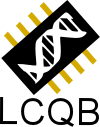You are here
Alessandra Carbone
Primary tabs
Found 91 results
Filters: Author is Ladant, Daniel and Keyword is Structure-Activity Relationship [Clear All Filters]
. Large scale chromosomal mapping of human microRNA structural clusters. Nucleic Acids Res. 41(8), pp.4392-408 (2013).
. Protein-protein interactions in a crowded environment: an analysis via cross-docking simulations and evolutionary information. PLoS Comput Biol. 9(12), pp.e1003369 (2013).
. CLAG: an unsupervised non hierarchical clustering algorithm handling biological data. BMC Bioinformatics. 13, pp.194 (2012).
. Protein Fragments: Functional and Structural Roles of Their Coevolution Networks. PLoS ONE. 7(11), pp.e48124 (2012).
. Co-evolution and information signals in biological sequences. Theoretical Computer Science. 412, pp.2486 - 2495 (2011).
. A discriminative method for family-based protein remote homology detection that combines inductive logic programming and propositional models. BMC Bioinformatics. 12, pp.83 (2011).
. Chromosomal periodicity and positional networks of genes in Escherichia coli. Mol Syst Biol. 6, pp.366 (2010).
. MIReNA: finding microRNAs with high accuracy and no learning at genome scale and from deep sequencing data. Bioinformatics. 26(18), pp.2226-34 (2010).
Co-evolution and Information Signals in Biological Sequences. in Theory and Applications of Models of Computation. LNCS 5532, Springer Berlin Heidelberg. pp. 6-17 (2009)
. A combinatorial approach to detect coevolved amino acid networks in protein families of variable divergence. PLoS Comput Biol. 5(9), pp.e1000488 (2009).
Information content of sets of biological sequences revisited. in Algorithmic Bioprocesses. Springer. pp. 31–42 (2009)
. Joint evolutionary trees: a large-scale method to predict protein interfaces based on sequence sampling. PLoS Comput Biol. 5(1), pp.e1000267 (2009).
. Codon bias is a major factor explaining phage evolution in translationally biased hosts. J Mol Evol. 66(3), pp.210-23 (2008).
. Environmental and Physiological Insights from Microbial Genome Sequences. Elements of Computational Systems Biology. pp.325–339 (2008).
. Identification of Protein Interaction Partners and Protein–Protein Interaction Sites. Journal of Molecular Biology. 382, pp.1276 - 1289 (2008).
. Inconsistent distances in substitution matrices can be avoided by properly handling hydrophobic residues. Evol Bioinform Online. 4, pp.255-61 (2008).
Adaptation studied with the self-consistent codon index: genomic spaces, metabolic network comparison, minimal gene sets and viral classification. in Proceedings of the Evry Spring School on Modelling Complex Biological Systems in the Context of Genomics. Genopole, Evry. EDP Sciences. (2007)
. Metagénomique bactérienne et virale - nouvelles définitions d'espace microbien et nouveaux défis algorithmiques. Technique et Sciences Informatiques, special issue on "Modeling, simulations in postgenomics", Hérmes. (2007).
. New Highly Divergent rRNA Sequence among Biodiverse Genotypes of Enterocytozoon bieneusi Strains Isolated from Humans in Gabon and Cameroon. Journal of Clinical Microbiology. 45, pp.2580-2589 (2007).
. Periodic distributions of hydrophobic amino acids allows the definition of fundamental building blocks to align distantly related proteins. Proteins. 67(3), pp.695-708 (2007).
. Computational prediction of genomic functional cores specific to different microbes. J Mol Evol. 63(6), pp.733-46 (2006).
Une opération de docking croisé à grande échelle pour la détection de partenaires protéiques potentiels. in Proceedings of the workshop "Mathématiques et Interactions". Paris France. Institut Henri Poincaré. (2006)
. Codon bias signatures, organization of microorganisms in codon space, and lifestyle. Mol Biol Evol. 22(3), pp.547-61 (2005).
(Eds.)DNA Computing. Proceedings of the 11th International Workshop on DNA Computing - DNA11. London (ON, Canada). LNCS 3892, Springer. (2005).
. Insights on the evolution of metabolic networks of unicellular translationally biased organisms from transcriptomic data and sequence analysis. J Mol Evol. 61(4), pp.456-69 (2005).



